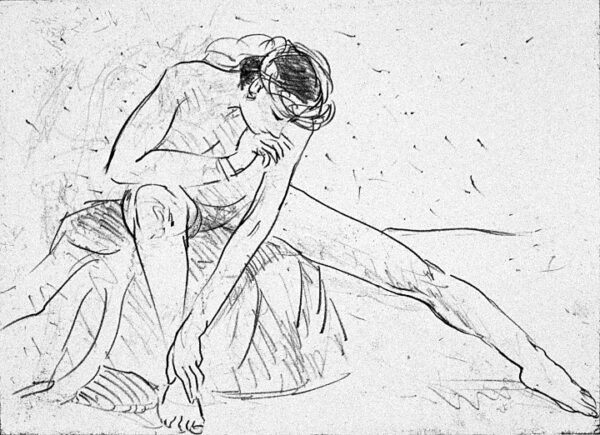June Felter was a figurative painter from the Bay Area, where she lived and worked all of her life. She was born in 1919 in Oakland, California and studied at the Oakland Art Institute, the California College of Arts and Crafts, and the San Francisco Art Institute. She married Richard Henry Felter in 1943 and had two children, Susan and Tom. Felter was a commercial illustrator before and during World War II, but transitioned to painting in the 1950s. She is influenced by artists of the Bay Area figurative movement, especially Richard Diebenkorn, Elmer Bischoff, and David Park. “Bay Area Figurative art showed me a vision of possibilities- freedom, how to paint more simply,” says Felter. Her paintings and prints are representative of her everyday life; figures and still lifes are the subject matter. Working mostly in watercolor, Felter expresses a romantic style through her attention to detail and gesture. She explains, “if I pick out something to draw or paint it’s always something I like. I like the way a still life, or a landscape, or the body looks.” A pivotal moment in Felter’s life was when she viewed David Park’s exhibition at the de Young Museum in San Francisco in 1959; she claimed to be “bowled over” by his work. A year later, Felter took a class at the San Francisco Art Institute taught by Richard Diebenkorn; this furthered her practice of the figurative style. Felter and Diebenkorn were also participants of etching workshops that were held every Friday evening in Kathan Brown’s basement for the first two years of Crown Point Press’s beginning in the ‘60s.
In 1997, Felter became part of Crown Point’s published portfolio titled “Live Model Group” which included work by Nathan Oliveira, Enrique Chagoya, and Fred Dalkey. The four artists drew directly on copper plates while a live model posed. Felter remarked that “a nude model stands for ‘art’ in many people’s minds, but it also shows an interest in ourselves as human beings. Besides being pleasurable for me, drawing the model seems to be a necessary exercise for keeping flexible, sensitive, and open to surprise.”
June Felter had solo shows at Linda Ferris Gallery, Seattle; Lloyd Clark Gallery, Oakland; 871 Fine Arts, San Francisco; and the Richmond Art Gallery, Richmond, California. She was in numerous group exhibitions, including the International Women’s Art Exhibit in Denmark and the California Society of Printmakers at the Museum of Tokyo in Japan. She is represented in San Francisco by 871 Fine Arts Gallery and in New York by Susan Rush Fine Art. June Felter died at the age of 99 on July 16, 2019.
–Carleigh Koger
WHY DRAW A LIVE MODEL?


